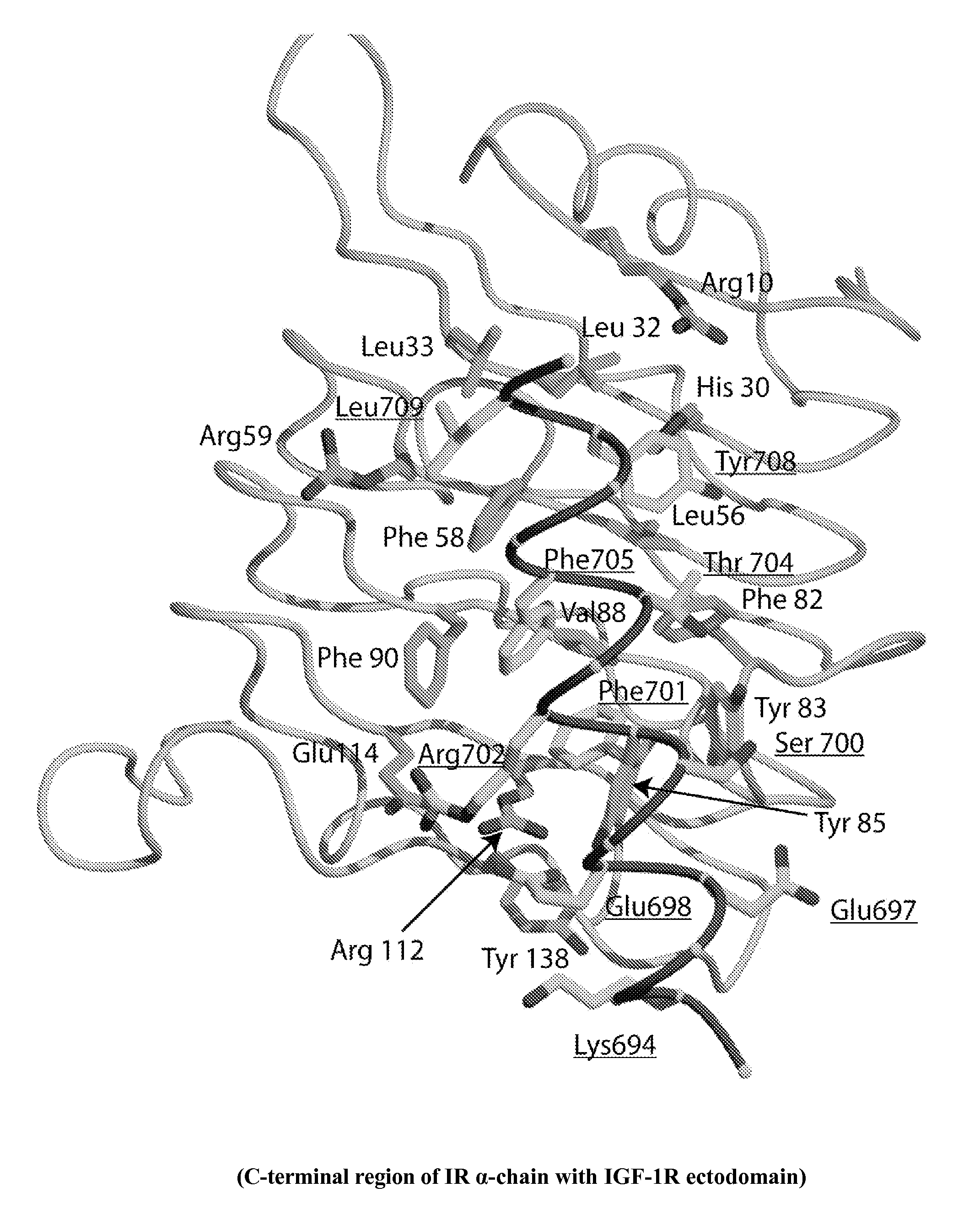STRUCTURE OF THE C-TERMINAL REGION OF THE INSULIN RECEPTOR a-CHAIN AND OF THE INSULIN-LIKE GROWTH FACTOR RECEPTOR a-CHAIN
a technology of c-terminal region and insulin receptor, which is applied in the field of structural studies of the insulin binding site of the insulin receptor and the insulinlike growth factor 1 receptor (igf1r), can solve the problems of infertility, impaired postnatal growth, and embryonic growth deficiency, and the conclusions of these studies have been questioned
- Summary
- Abstract
- Description
- Claims
- Application Information
AI Technical Summary
Benefits of technology
Problems solved by technology
Method used
Image
Examples
example 1
A Thermodynamic Study of Ligand Binding to the First Three Domains of the Human Insulin Receptor (IR): Relationship Between the IR α-Chain C-Terminal Peptide (αCT) and the Site 1 Insulin Mimetic Peptides
1.1 Introduction
[0295]In order to study ligand binding to the first three domains of IR ectodomain, isothermal titration calorimetry (ITC) was used. ITC allowed a direct assay of the interactions between the IR ectodomain classical αCT peptide (residues 704-719; SEQ ID NO: 11) and IR485 (a construct consisting of the first three N-terminal domains of the IR; SEQ ID NO: 10), as well as the interaction between the analogous peptide of human IGF-1R and IR485. At the same time the thermodynamics of binding of the N- and C-terminal segments of the insulin mimetic peptide S519 (Schäffer et al., 2003) to IR485, as well as the binding of S519 itself to IR485 were examined. S519 (SLEEEWAQVECEVYGRGCPSGSLDESFYDWFERQLG; SEQ ID NO: 16) is a 36-residue peptide resulting from the affinity-optimizat...
example 2
Solving the Crystal Structure of the C-Terminal Region of the α-Chain of IR
2.1 Introduction: Ambiguous Electron Density
[0304]As described previously (WO 07 / 147,213), an area of strand-like ambiguous electron density was present near the L1-β2 face of IR. However, despite numerous different processing and refinement protocols, the density was impossible to interpret in terms of any peptide sequence. The data described in Example 1 above implied a surprising and previously unexpected sequence relationship between the S519C16 peptide (SEQ ID NO: 18) and the ‘classical’αCT peptide region (residues 704-719; SEQ ID NO: 11) described previously in the literature (Kurose et al., 1994). X-ray data obtained in WO 07 / 147,213 were revisited and further reviewed with the possibility then in mind that the ambiguous electron density near the L1-β2 face of IR could have been due to the ‘classical’αCT peptide region of the IR α-chain.
2.2 Protein Production, Crystallisation and Data Collection from I...
example 3
3.1 Introduction
[0312]There is a high level of sequence identity between, on the one hand, the L1 domains of IGF-1R and IR, and, on the other hand, between the C-terminal regions of the α-chain of IGF-1R and IR (FIG. 1 and FIG. 6c). Accordingly, models of IR in complex with S519C16 and the IGF-1R α-chain residues 681-697, respectively, were constructed using the MODELLER program (Sali and Blundell, 1993) with the crystallographic structure of IR ectodomain presented in the main text as a template. Models of the ectodomain of IGF-1R in complex, respectively, with the IGF-1R α-chain residues 681-697 (SEQ ID NO: 15), S519C16 (SEQ ID NO: 18) and the IR α-chain residues 693-710 (SEQ ID NO: 13) were constructed employing the crystal structure of the first three domains of IGF-1R (Garrett et al., 1998), the structure of the IR ectodomain presented here and the known sequence relationship between IR and IGF-1R (Adams et al., 2000).
3.2 Materials and Methods for Modelling
[0...
PUM
| Property | Measurement | Unit |
|---|---|---|
| Fraction | aaaaa | aaaaa |
| Volume | aaaaa | aaaaa |
| Molar density | aaaaa | aaaaa |
Abstract
Description
Claims
Application Information
 Login to View More
Login to View More - R&D
- Intellectual Property
- Life Sciences
- Materials
- Tech Scout
- Unparalleled Data Quality
- Higher Quality Content
- 60% Fewer Hallucinations
Browse by: Latest US Patents, China's latest patents, Technical Efficacy Thesaurus, Application Domain, Technology Topic, Popular Technical Reports.
© 2025 PatSnap. All rights reserved.Legal|Privacy policy|Modern Slavery Act Transparency Statement|Sitemap|About US| Contact US: help@patsnap.com



